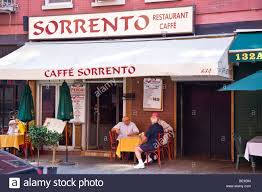Italian cuisine has ingrained itself into a huge part of the American food culture. It has allowed for individuals to have a unique experience and look into the floodways and culinary capital of the Italian people. This is all highlighted very well in Sheryll Bellman’s cookbook America’s Little Italys – Recipes & Traditions from Coast to Coast. Bellman has an interesting background with a B.S. in microbiology and a PHD in Immunology; she decided against pursuing a career in science and followed her passion for cultural history and pop culture. She has written two other books, Through The Shopping Glass: A Century of Christmas Windows in New York City and America’s Great Delis – Recipes and Traditions from Coast to Coast. Her love for cultural history and pop culture is shared with her readers especially well in America’s Little Italys – Recipes & Traditions from Coast to Coast. She gives the reader a look into the history of the mass Italian Immigration into the United States in the early 1900’s. She allows the reader to fully experience the different culinary capital the Italian Americans bring throughout all the different regions of America.
 (Sheryll Bellman)
(Sheryll Bellman)
The rise of Italian cuisine in American culture can be traced back to the early immigration of Italians into American starting in the early 1900’s. They came over in hopes of being able to make enough money to maybe one day return back to Italy with enough money to have a better life than they did before. However, many found America to be their permanent home. This has resulted in the formation of “Little Italy’s” all across America. Many of these places have remained virtually unchanged. “The Old World charm is evident in the bright awnings of Italian restaurants, and the smell of fresh bread, garlic and marinara sauce wafting from them, as well as music that seems to come right up from the sidewalk” (Bellman 11). What is so special among these communities is that, although the share the same ethnicity, there distinct differences among each of them based off the regions which they originated. These very evident in the differences between the Little Italy’s in New York compared to those in San Diego. The Italian cuisine that can be seen in New York is dominated by delicious marinara sauces, pasta dishes, and rich flavorful cheese. The Italian cuisine we seen in San Diego differs greatly because of the region the original Italian immigrants came from. Many of these immigrants came from Naples and Sicily. “San Diego was the ideal spot for them as the weather closely resembled that of their homes of Genoa, Naples or Sicily. And since most of the Italians were fishermen by trade the coastal setting was perfect for them” (Bellman 203). This led to a high incorporation of fresh fish into the cuisine of the immigrants in this region.

The culture within these “Little Italys” revolved around an extremely closely knit community. In the case of the families that lived in the Italian communities of San Diego. The day to day life revolved around food and the connections made from cooking. The majority of the men would go off to their boats to fish every morning with freshly baked bread made by their wives so that they would not be hungry while out on the water. When the men would return, there would be delicious dinners prepared. “If the catch was good that day, the brick ovens would be fired up, the garlic was sautéed, the wine poured, and a feast would be enjoyed by all” (Bellman 204). However, there was also another key part of their society that involved gathering together for good meals. The Italian community had deep religious roots that they brought with them from Italy. It brought the community together and got them through hard times. Every Sunday after mass the families would get together to enjoy meals prepared by all for all. “From christenings to funerals, it was the core that would bring friends and relatives together for Sunday masses, spaghetti suppers, newsletters, street processions and carnivals” (Bellman 204). Religion was a huge part of their culture that brought them together to enjoy their delicious cuisine.

The rise of restaurants now in these Little Italy’s is an amazing way that they continue to carry on their culture and share it with the rest of the world. However, it is almost comical that they decided to create their own restaurants. When first arriving in America, many of them refused to eat at an restaurant. Women refused to take their families out to eat as they took pride in their cooking and thought it embarrassing if they were not the ones to make the meals. “For the newly arrived Italian immigrants, meals were not taken in restaurants as that would have meant that Mama was a terrible cook: rather, the meals that were served at home, at mother’s and grandmother’s table, were a triumph of excess” (Bellman 11). If food was going to be prepared, it had to be the mother who made it. Although the belief that the women in the family are the best cooks in the house, that idea is starting to change as more and more men decided to open up restaurants.
The ingredients in Italian cuisine are rich with many different tastes and flavors. The basic principle of the cuisine relies on using the freshest ingredients. Fresh cheeses, grains, and different types of meats make up a big part of the Italian diet. However, one often overlooked component is the emphasis placed on the spices, seasonings and herbs. Rosemary, Basil and garlic are all important components in the Italian diet and are used quite frequently. Another interesting ingredient often found in Italian cuisine is wine. However, wine as an ingredient is held to a certain standard and that standard is, if it’s not good enough to drink on its own then it’s not good enough to use to cook.

The recipe layout within the book is very exact with amounts and measurements used for each recipe. Such examples include, 1 large onion chopped (about 2 cups). This gives the reader of an idea on how much 1 large onion is if they have never used a large onion before. Also, the instructions on how long to cook the dish, what to preheat the oven to and any other preparations that must be taken are clearly stated within the text.
As for the reader or audience who might be entertained by this book, it is very versatile. It provides some brief history within the book that the average person might not know, but many of the recipes are so unique anyone, regardless of skill level. Would enjoy using this cookbook. Also, the instructions are so easily laid out and clearly stated that no one should have a real problem using the cookbook. Overall, Sheryll Bellman did a fantastic job of sharing her love for cultural history and pop culture with the reader.
RESOURCES
Bellman, S. (2010). Americas little Italys: Recipes & traditions from coast to coast. Portland, Me.: Sellers Pub.
Sheryll Bellman. (2016, October 11). Retrieved from http://www.sheryllbellman.com/